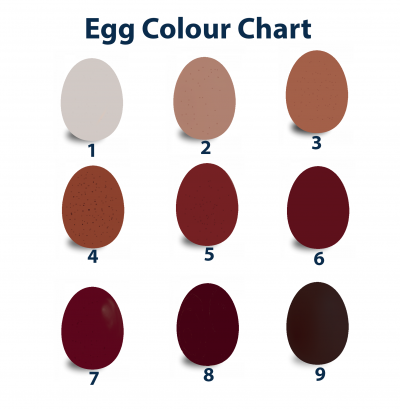Marans
| Marans | |||
|---|---|---|---|
| Origin | Category | Egg Colour | Sitter |
| France | Softfeather Heavy | Brown | Yes |

The Marans is best known for its dark chocolate-coloured eggs. It is a well built bird of average size that was created for both meat and egg production. I has plumage held close to the body giving an impression of strength without looking heavy and awkward. It it known for brown egg production with the best eggs being very big and a dark red-brown colour. The breed originated in France (taking its name from a town there) and was imported to Britain in 1929. It was later introduced to Australia where it was popular for a few years and then dwindled to become almost extinct. Numbers were rebuilt in Australia from remnant flocks which were discovered by a few passionate breeders. Australian stocks were later bolstered by birds imported with the well-known Avgen imports.
GENERAL CHARACTERISTICS
MALE
Carriage: Active, compact and graceful.
Head: The Marans should have a neat and refined head.
Comb: Single, medium size, straight and erect, five to seven serrations - of fine texture.
Beak: Deep and of medium size.
Face: Smooth and fine in texture.
Eyes: Large and prominent.
Skull: Refined.
Neck: Medium to long, rather strong to the head and not too profusely feathered.
Body
Body: Medium to long with good width and depth throughout indicating mass. Wide especially at the shoulders which are held high. Front broad full and deep.
Back: Medium length.
Breastbone: Long, well-fleshed and of good width. Well-covered with flesh in front and without keeliness.
Flesh: White and of good quality.
Skin: Thin and of fine texture.
Tail: Well carried high tail.
Body and Fluff:
Legs and Toes: Medium in length, To ensure full table front wide apart but not too heavy in bone. Toes well-spread and straight. Shanks either clean and unfeathered, or if the feathered type - sparse feathering on the outside of the shank and on the outside toe.
Plumage: Fairly tight and of silky texture generally.
Handling: Firm as befits a table breed.
SHAPE OF FEMALE
Generaly characteristics of the female are similar to the male allowing for natural sexual differences. Table qualities to laying qualities to be taken carefully into account jointly.
COLOUR
Comb, face, wattles and earlobes: red.
Legs and feet: White
Beak: White and horn
Eye: Red or bright orange. Pupil large and defined
Black
Male and female plumage is black with a good green sheen.
Dark Cuckoo
Male and female plumage: Cuckoo throughout, each feather barred across with bands of blue-black. A lighter shaded neck in both male and female, and also back in the male, is permissible if definitely banded. Cuckoo throughout is the ideal, as even as possible.
Golden Cuckoo
Male plumage: Hackles bluish-grey with golden and black bands, neck paler than saddle. Breast bluish-grey with black bands, pale golden shading on upper part. Thighs and fluff light bluish-grey with medium black banding. Back, shoulders and wing bows bluish-grey with rich brought golden and black bands. Wing bars bluish-grey with black bands, golden fringe permissible. Wings, primaries dark blue-grey, lightly banded, secondaries dark blue-grey, lightly banded, with slight golden fringe. Tail dark blue-grey banded with black, coverts blue-grey banded with black. General cuckoo markings.
Female plumage: Hackle medium bluish-grey with golden and black bands. Breast dark bluish-grey with black bands, pale golden shading on upper parts. Remainder dark bluish-grey with dark black bands. Cuckoo markings.
Silver Cuckoo
Male — Mainly white in neck, and showing while on upper part of breast, also on top. Remainder and in general barred throughout, with lighter ground colour than the Dark Cuckoo.
Female — Mainly white in neck, and at the moment showing white on upper part of breast. Remainder barred throughout, with lighter ground colour than the Dark Cuckoo.
Black Copper
Black with copper feathers on the neck.
Blue Copper
Blue with copper feathers on the neck.
Other Colours
The Marans is bred in other colours. For other colour details the Pekin bantam colour standards is a point of reference.
STANDARD WEIGHTS
Note that there are some small discrepancies between Marans standards with regard to weights. As it is a meat fowl a solid meaty bird is required. It is not a fluffy plumaged fowl so the neat trim feathering displays the body shape of the dual-purpose fowl well.
STANDARD WEIGHTS OF LARGE FOWL
Cock: 3.5 to 4kg Hen: 2.6 to 3.2kg
Cockerel: 3.0 to 3.5kg Pullet: 2.2 to 2.6kg
STANDARD WEIGHTS OF BANTAMS
Bantam Marans to be approximately one third of their standard counterparts.
POINTS
- Type, carriage, and table merits (to include type of breast and fleshing, also quality of flesh). 40;
- Size and quality, 20;
- Colour and markings, 15;
- Head points, 10;
- Condition, 10;
- Legs, 5.
DISQUALIFICATIONS
- Heavily feathered shanks
- General coarseness
- Lack of activity
- Superfine bone
- Any points against reproductive values
- Any deformity eg crooked breastbone
Serious Defects
- White in lobe
- Dark pigmentation in white shanks
SOURCES & LINKS
- MARANS (1935, August 17). The Australasian (Melbourne, Vic. : 1864 - 1946), p. 42. Retrieved March 7, 2020, from http://nla.gov.au/nla.news-article141761053
- Australian Marans Club website: http://frenchmaransclubaustralia.yolasite.com/standard.php
- UK Marans Club site: http://www.themaransclub.co.uk/
- European Marans Club website: http://marans.eu/standang.htm#standard
- Australian Poultry Standards Ed2





